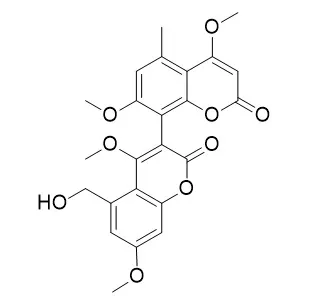| In vitro: |
| Fungal Genet Biol. 2017 Jul;104:29-37. | | Aspergillus flavus aswA, a gene homolog of Aspergillus nidulans oefC, regulates sclerotial development and biosynthesis of sclerotium-associated secondary metabolites.[Pubmed: 28442441] |
METHODS AND RESULTS:
Aspergillus flavus aswA (AFLA_085170) is a gene encoding a Zn(II)2Cys6 DNA-binding domain and a transcriptional activation domain, DUF3468. Disruption of aswA yielded strains that made a truncated gene transcript and generated a fungus that produced a greatly increased number of sclerotia. These sclerotia were odd-shaped and non-pigmented (white) and different from oval and pigmented (dark brown to black) mature sclerotia. Transcriptomic analysis of the ΔaswA strain grown on potato dextrose agar plates and Wickerham agar plates showed that expression of clustering genes involved in the biosynthesis of three sclerotium-associated secondary metabolites was down-regulated. These included gene clusters of asparasone, aflatrem, and Aflavarin. In contrast, those of aflatoxin, cyclopiazonic acid and kojic acid were not affected.
CONCLUSIONS:
Metabolite analyses confirmed that the non-pigmented sclerotia contained aflatoxin and cyclopiazonic acid but not other aforementioned metabolites, three asparasone analogs and dihydroxyaflavinine commonly present in mature sclerotia. Impairment in aswA gene function stalls normal sclerotial development, which in turn prevents biosynthesis and accumulation of sclerotium-specific metabolites. | | Journal of Natural Products, 1992, 55(8):1080-1086. | | Aflavarin and β-Aflatrem: New Anti-Insectan Metabolites from the Sclerotia of Aspergillus flavus[Reference: WebLink] |
METHODS AND RESULTS:
Aflavarin [3], a new bicoumarin, and beta-aflatrem [11], an isomer of the tremorgen aflatrem, were isolated from the sclerotia of Aspergillus flavus. The structures were determined through a series of 1D and 2D nmr experiments, assisted by spectral comparisons with known compounds. Aflavarin exhibits potent antifeedant activity against the fungivorous beetle Carpophilus hemipterus. Beta-aflatrem causes a significant reduction in the growth rate of the corn earworm Helicoverpa zea.
CONCLUSIONS:
The presence of nominine [13] as a minor metabolite of A. flavus is reported for the first time. |
|






 Cell. 2018 Jan 11;172(1-2):249-261.e12. doi: 10.1016/j.cell.2017.12.019.IF=36.216(2019)
Cell. 2018 Jan 11;172(1-2):249-261.e12. doi: 10.1016/j.cell.2017.12.019.IF=36.216(2019) Cell Metab. 2020 Mar 3;31(3):534-548.e5. doi: 10.1016/j.cmet.2020.01.002.IF=22.415(2019)
Cell Metab. 2020 Mar 3;31(3):534-548.e5. doi: 10.1016/j.cmet.2020.01.002.IF=22.415(2019) Mol Cell. 2017 Nov 16;68(4):673-685.e6. doi: 10.1016/j.molcel.2017.10.022.IF=14.548(2019)
Mol Cell. 2017 Nov 16;68(4):673-685.e6. doi: 10.1016/j.molcel.2017.10.022.IF=14.548(2019)